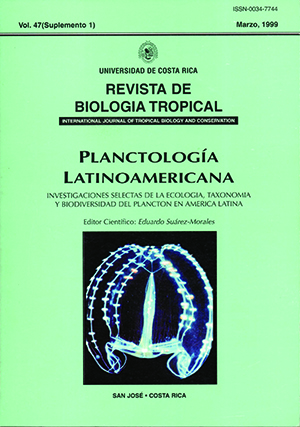Abstract
Phytoplankton was sampled monthly during the lune 1995-May 1996 period, at 16 stations of the eastern Gulf of Cariaco. This area receives different wastes. Only chlorophyll and diatoms, dinoflagellates, and total density of phytoplankton varied by depth. Only salinity and oxygen showed horizontal spatial differcl1tiation. Phytoplunkton maxima in November- December, were related with low nitrogenous nutrients and temperature, high phosphate, chlorophyll, and dissolved oxygen. The June-October period was characterized by high temperature, low oxygen, nutrient concentrations and phytoplankton abundance. Overall, phytoplankton abundances were low. Diatoms dominated during the sampling period, but microflagellates and dinoflagelates did occasionally. Phytoplankton density was positively correlated with phosphate and negatively with nitrogen. In spite of the high nutrient supply, phytoplankton growth was limited by a reduced light penetration related to concentrations of suspended particles.
References
Blasco, D. 1977. Red tide in the upwelling region of Baja California. Límnol. Oceanogr. 22: 255-263.
Eppley. R. W. & W. G. Harrison. 1975. Physiological ecology of Gonyaulax polyedro, a red water dinoflagellate of southern California. p. 11-22. In LoCicero. V. R. (e.d.) Proc. fnter. Conf. (1st) on Toxic Dinoflagellate
Blooms. Mass. Sci. Tech. Found. Wakefíeld. Massachusetts.
Ferraz - Reyes, E. 1976. Ciclo anual del fitoplancton en zonas de naneos naturales y de cultivo del mejillón Perna perna (L) en ef oriente de Venezuela. Bol. Inst. Oceanogr. Univ. Oriente. 15: 119-132.
Ferraz-Reyes, E. 1987. Productividad primaria del Golfo de Cariaco, Venezuela. Bol Inst. Oceanogr. Univ. Oriente. 26: 97-110: 8 tigs, I tab.
Ferraz-Reyes, E. & E. Femández. 1990. Ciclo anual de las bacterias heterotrofas planctónicas y del fitoplancton en el Gol fo de Caliaco, Venezuela. Bol. Inst. Oceanogr. Venezuela. Univ. Oliente. 29: 43-56, 10 figs., I tab.
Gade, H. G. 1961. On the hidrographic conditíons in the Gulf of Cariaco during the months from May to November 1960. Bol. Inst. Oceanogr. Unív. Oriente, 1: 21-46
Goldman, J. C., J. J. McCarthy & D. G. Peavey. 1979. Growth rate inf1uence on the chemical composition of phytoplankton in oceanic waters. Nature. 279: 210-215
MacIsaac, J. 1978. Diel cycJes of inorganic nitrogen uptake in a natural phytoplankton population dominated by Gonyaulax polyedra. Limnol. Oceanogr. 23: 1-9.
Mandelli, E. & E. Ferraz-Reyes. 1982. Primary production and phytoplankton dynamics in a tropical inlet, Gulf of Cariaco, Venezuela. Jnter. Revue. ges. Hydrobiol. 67: 85-95.
Okucla, T. 1981. Water exchange and the balance of phophate in the Gulf of Cariaco, Venezuela. Coast. Estuar. Sci. 1: 274-281.
Richards, F. 1960. Some chemical and hydrographic observations along the north coast of South America. I. Cabo Tres Puntas to Curazao, including (he Cariaco Trench and the Gulf of Caridco. Deep Sea Res. 3: 214-228.
Siaburth, J. M. & P. G. Davis. 1982. The role of he terotrophic nannoplankton in lhe grazing and nurturing of planktonic bacteria in the Sargasso and Caribbean Seas. Ann. Inst. Oceanogr. (Pulis). 58: 285-295.
Silllpson J. G. & R. C Griffiths. 1971. Afloramiento y producción biológica en el Golfo de Cariaco, Venezuela. Serie Recursos y Explotación Pesqueras. 2: 3-16.
Strickland, J. & T. Parson. 1872. A practical handbook of sea water analysis. Bull. Fish. Res. Board. Can. 167: 1-310 (2nd edition).
Utermohl, H. 1958, Zur vervollkommnung der quantitativen phytoplankton-methodik. Mitt. Int. Verein. Theor: Angrew. Limnol. 9: 1-38.
Comments

This work is licensed under a Creative Commons Attribution 4.0 International License.
Copyright (c) 1999 Revista de Biología Tropical


